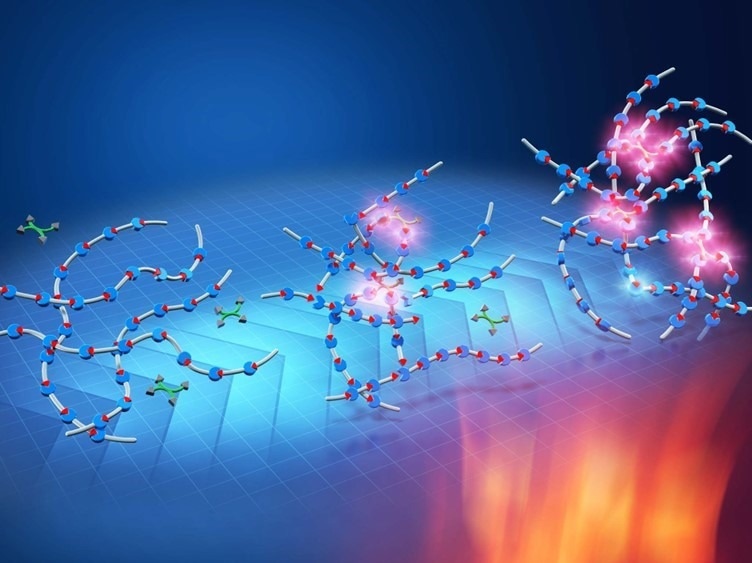Although plastics and synthetic polymers have a variety of beneficial qualities, poor management has led to extensive pollution that harms our ecosystems. Polyethylene terephthalate (PET), one of the most popular materials usually found in the recycling loop in many countries, is one of the synthetic polymers sent for reprocessing and recycling as a remedy for this.
 Creating high-value vitrimers from ordinary polyesters. Scientists have developed a one-shot process to transform commonly available polymeric plastics, such as polyesters into highly functional materials called “vitrimers” that can be easily recycled into useful products while retaining enhanced thermo-mechanical properties of the original polymer. Image Credit: Dr. Mikihiro Hayashi and Nagoya Institute of Technology, Japan
Creating high-value vitrimers from ordinary polyesters. Scientists have developed a one-shot process to transform commonly available polymeric plastics, such as polyesters into highly functional materials called “vitrimers” that can be easily recycled into useful products while retaining enhanced thermo-mechanical properties of the original polymer. Image Credit: Dr. Mikihiro Hayashi and Nagoya Institute of Technology, Japan
Recycling, however, comes with a unique set of issues. Partially broken polymer chains result in fundamentally inferior, degraded polymers when plastic is recycled. These subpar recycled plastics only work well as solid fuels because their characteristics have been vastly reduced.
Manufacturers are left with no alternative but to use rapidly decreasing petroleum feedstocks to create new plastic items.
As a result, scientists worldwide are working to create cross-linked polymer materials that are sustainable and affordable to recycle.
Dr. Mikihiro Hayashi, an assistant professor at Nagoya Institute of Technology in Japan, and his colleague Takahiro Kimura have created a simple process for recycling polyester, a widely used synthetic material, into a cross-linked polymer that keeps its strength and properties when recycled.
They base their technique on converting polyesters into vitrimers, a new family of polymers with dynamic covalent connections that can reversibly break and reconstruct to produce new cross-links.
The vitrimer has desirable qualities that make it a high-value functional material, including recyclability, reprocessability, and healing powers, thanks to the dynamic covalent bonds. On August 1st, 2022, the study was released in the Journal of Materials Chemistry A.
Our research demonstrates a one-shot upcycling process of commercial polyesters into cross-linked vitrimers with enhanced thermo-mechanical properties and sustainable functions.
Dr Mikihiro Hayashi, Assistant Professor, Nagoya Institute of Technology
Combining polyester with the cross-linker molecule tetra-epoxy, the chemical 1,8-diazabicyclo [5.4.0] undec-7-ene (DBU) as a catalyst, and tetrahydrofuran as the solvent, he and his colleague were able to produce the vitrimers. The combination was then heated at 200 °C for 24 hours to create a coating of vitrimer after removing the solvent.
This technique involves three quick consecutive steps for cross-linking to create vitrimer: hydrolysis (breaking of the polyester bonds), epoxy-opening reaction, and intermolecular transesterification.
Dr Hayashi added, “The highly cross-linked and recyclable vitrimer exhibits a 60-fold increase in tensile modulus or Young’s modulus and a 10-fold increase in the maximum endurable stress when compared with the original polyester. It also has a gel fraction of nearly 100%.”
The vitrimer was also shown to maintain its qualities even after being broken into fragments and compacted into a flat sheet, confirming its suitability for recycling.
Since they are lightweight, affordable, non-toxic, and simple to create, plastics are necessary materials with various advantages and practical qualities. The environmental damage they cause needs to be acknowledged and minimized, though, at the same time.
By making plastic polymers more reusable, recycling initiatives will be supported and less petroleum, a non-renewable resource, will be consumed.
“The world needs versatile options for recycling synthetic polymers. The method we propose will not only eliminate the use of petroleum-derived chemicals, but it could also be the first step towards a practical and sustainable upcycling system for the future, which adheres to the principles of circular economy and helps realize the SDGs,” stated Dr Hayashi.
As a next step, the researchers want to develop a method that converts polyesters more directly into vitrimer without using any solvents. They are also considering using their technique to convert commercial PET into other highly recyclable materials.
If implemented successfully, the technology could result in a closed-loop plastic production system, preventing any subsequent environmental catastrophes brought on by unchecked plastic manufacturing.
This study is based on findings from a New Energy and Industrial Technology Development Organization (NEDO, #JPNP20004)-funded initiative.
【Research】Recycling 2.0: Converting Ordinary Plastics into High-Value Vitrimers
Video Credit: Dr Mikihiro Hayashi and Nagoya Institute of Technology, Japan
Journal Reference
Kimura, T., et al. (2022) One-shot transformation of ordinary polyesters into vitrimers: decomposition-triggered cross-linking and assistance of dynamic covalent bonds. Journal of Materials Chemistry A. doi:10.1039/D2TA04110C.